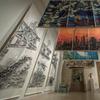The Davis Museum at Wellesley College Examines Postwar Art Collecting Trends in Fragment: A Museum’s Mid-Century Legacy
- WELLESLEY, Massachusetts
- /
- February 05, 2018
The Davis Museum at Wellesley College will present Fragment: A Museum’s Mid-century Legacy, an exhibition highlighting artworks collected by the Museum during the mid-20th century. Originally parts of larger works of art, these objects provide significant information about the roles that they played in mid-century modernism. The exhibition, co-curated by Dr. Meredith Fluke, Kemper Curator of Academic Exhibitions and Affairs, and Dr. Amanda Gilvin, Assistant Curator, will be on view in the Morelle Lasky Levine ’56 Works on Paper Gallery from February 13 through June 10, 2018.
“When studying the Davis’s collections, we discovered a significant influx of fragments during the 1950s. The objects stood out to us because they included many works from our respective areas of specialization: medieval European architectural fragments in my case, and West African art for Dr. Gilvin,” said Dr. Meredith Fluke.
The exhibition comprises approximately 20 disparate works of art— including a West African royal portrait, a South Asian Buddha, and a 17th-century Austrian angel—that come from many different times and places. These objects were removed, stripped, chiseled, ripped, and cleaned into presentable and aestheticized works of art. They came into the Wellesley College collections during the mid-20th century, an influential period for art collecting, museum growth, and art history throughout the United States due to the influx of new art, capital, and ideas from Europe.
Fragment also addresses how the collecting of historical art intersected with the rise of abstract expressionism. “During and after World War II, many Europeans moved to the United States, often bringing their collections and tastes in collecting with them,” said Dr. Amanda Gilvin. “At mid-century, American private collectors and galleries juxtaposed African sculpture with abstract painting, a trend that began in Europe.”
Organized in themes entitled: The Accessible Object, The Limits of a Fragment, Authenticity in Pieces, and Becoming Whole, the design and layout of the exhibition are consciously reminiscent of the clean, white aesthetic of the modernist period. The presentation also emulates the style of Wellesley College’s own Jewett Arts Center—an icon of architectural modernism designed by Paul Rudolph, which opened in 1958—and home to the College’s art collection before the Davis Museum was built by Rafael Moneo in 1993.
Fragment: A Museum’s Mid-century Legacy is accompanied by a Davis mobile app tour providing additional information on each of the fragments presented in the exhibition. Download the app at http://app.thedavis.org.
Fragment is presented with generous support from The Mary Tebbetts Wolfe ‘54 Davis Museum Program Fund.
https://www.wellesley.edu/davismuseum/
About Davis Museum
One of the oldest and most acclaimed academic fine arts museums in the United States, the Davis Museum is a vital force in the intellectual, pedagogical and social life of Wellesley College. It seeks to create an environment that encourages visual literacy, inspires new ideas, and fosters involvement with the arts both within the College and the larger community. ABOUT WELLESLEY COLLEGE AND THE ARTS The Wellesley College arts curriculum and the highly acclaimed Davis Museum are integral components of the College’s liberal arts education. Departments and programs from across the campus enliven the community with world-class programming– classical and popular music, visual arts, theatre, dance, author readings, symposia, and lectures by some of today’s leading artists and creative thinkers–most of which are free and open to the public. Since 1875, Wellesley College has been the preeminent liberal arts college for women. Known for its intellectual rigor and its remarkable track record for the cultivation of women leaders in every arena, Wellesley—only 12 miles from Boston—is home to some 2300 undergraduates from every state and 75 countries.










![Peter Paul Rubens (Flemish, 1577–1640), After Titian (Tiziano Vecelli) (Italian [Venetian], c. 1488–1576), Rape of Europa, 1628–29. Oil on canvas, 71 7/8 x 79 3/8 in. Peter Paul Rubens (Flemish, 1577–1640), After Titian (Tiziano Vecelli) (Italian [Venetian], c. 1488–1576), Rape of Europa, 1628–29. Oil on canvas, 71 7/8 x 79 3/8 in.](/images/c/e2/2e/Jan20_Rape_of_Europa100x100_c.jpg)





